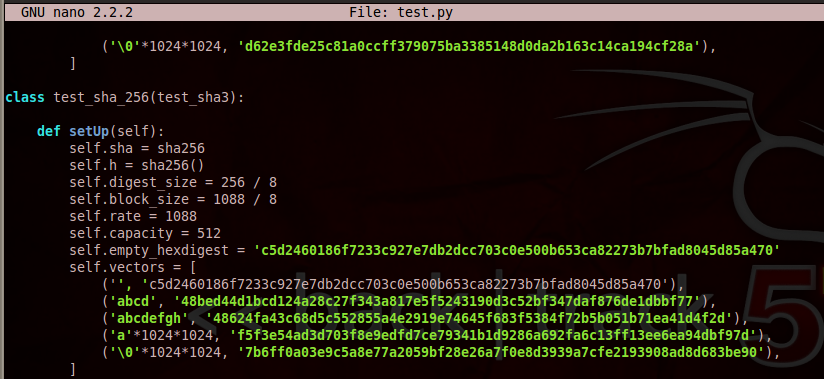TroubleshootingIn May, 2014, a student could not perform the git clone because it asked for a password. The only solution we could find was to use a different machine.If the "python setup.py build" fails, you may be missing some dependencies. This happened to a student who was using BT5 R1. To fix it, execute this command: |
Using the Modules in Python
In Linux, in a Terminal window, execute these commands:
python
from sha3 import sha256
s=sha256()
s.update("")
s.hexdigest()

But how can we know that is correct?
Here's the hash of an empty string, provided as a test case by the developers of SHA-3, from http://keccak.noekeon.org/files.html:

As you can see, the value is correct, starting with "c5d2"--it is working correctly!
Calculating the Hash of "abcd"
In Linux, in a Terminal window, at the interactive Python prompt >>>, execute these commands:
s=sha256()
s.update("abcd")
s.hexdigest()

Saving the Screen Image
Make sure the hash value starts with "48bed", as shown above.
Save a screen capture with a filename of "Proj 12xa from YOUR NAME".
Verifying the Hash Accuracy
The hash for "abcd" is included in the file "test.py" included in the git repository we cloned, as shown below:

As you can see, the string "abcd" hashes to a hash starting with "48bed", as expected.
The SHA-3 code is working.
Calculating the SHA-3 256-bit hash of "apple"
Using the procedure above, calculate the 256-bit hash of "apple". The correct answer starts with "85dca".To get credit you must send in the entire hash value--we'll check the end of it for accuracy. Save that as image "Proj 12xb from YOUR NAME"
Calculating the SHA-3 512-bit hash of "CCSF"
Using the procedure above, calculate the 512-bit hash of "CCSF". The correct answer starts with "85f1".To get credit you must send in the entire hash value--we'll check the end of it for accuracy. Save that as image "Proj 12xc from YOUR NAME"
Turning In Your Project
Email the images to cnit.120@gmail.com with a subject of "Project 12x from YOUR NAME".
Sources
https://github.com/ajakubek/python-sha3http://learn.github.com/p/setup.html
http://keccak.noekeon.org/files.html
Last modified: 12-9-14 12:24 pm